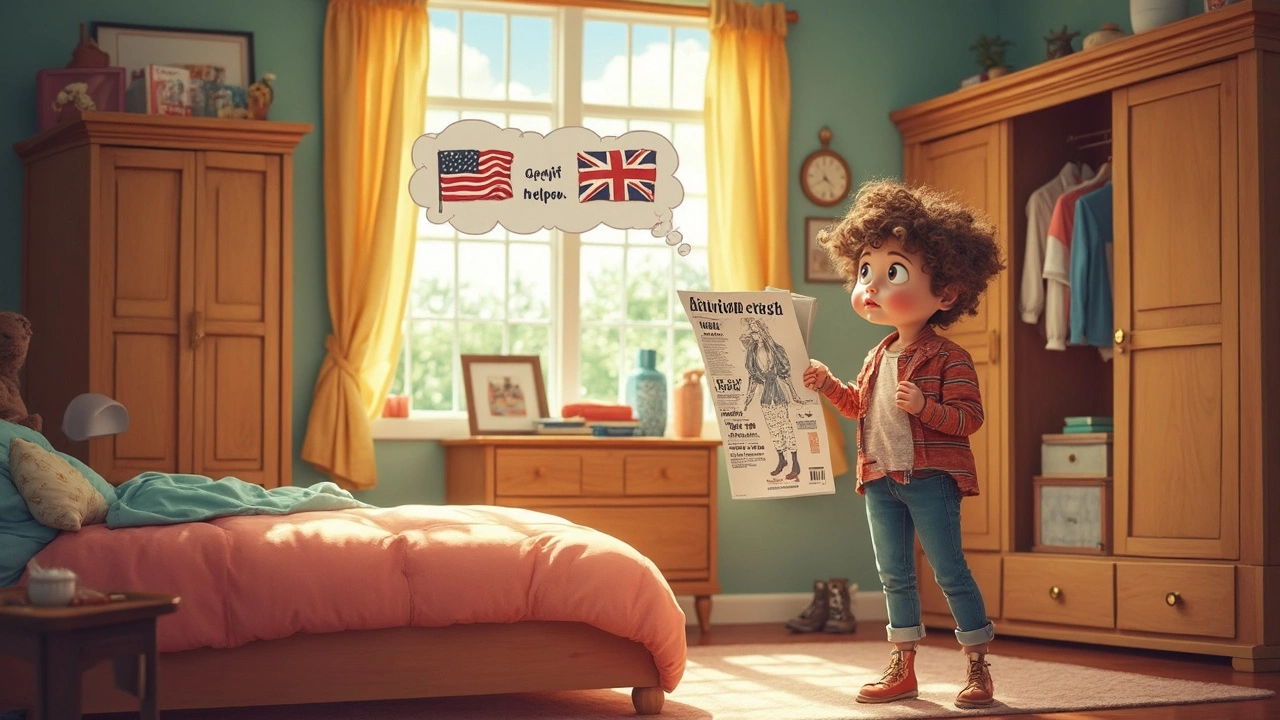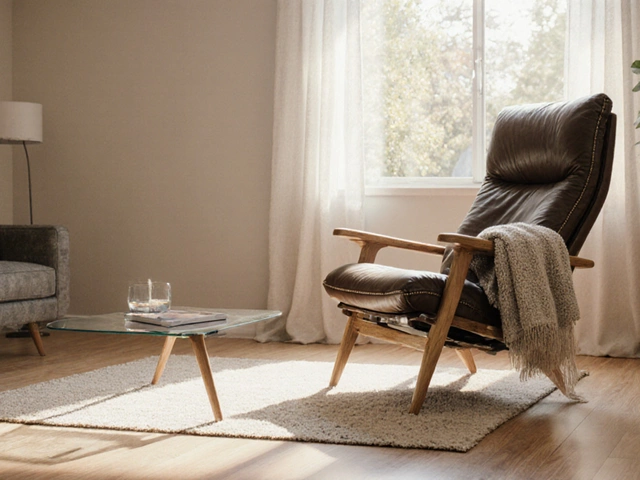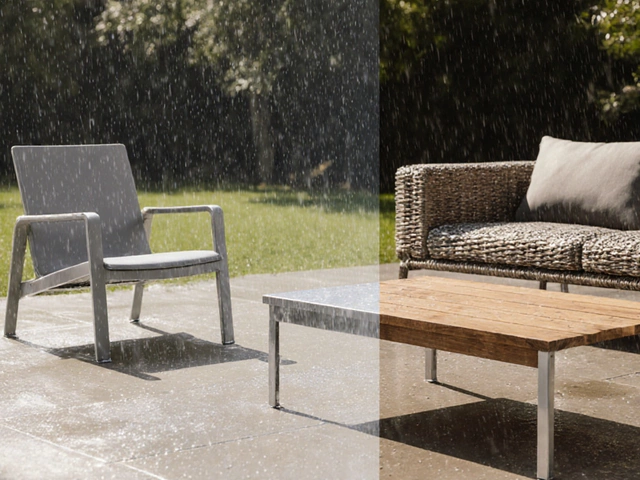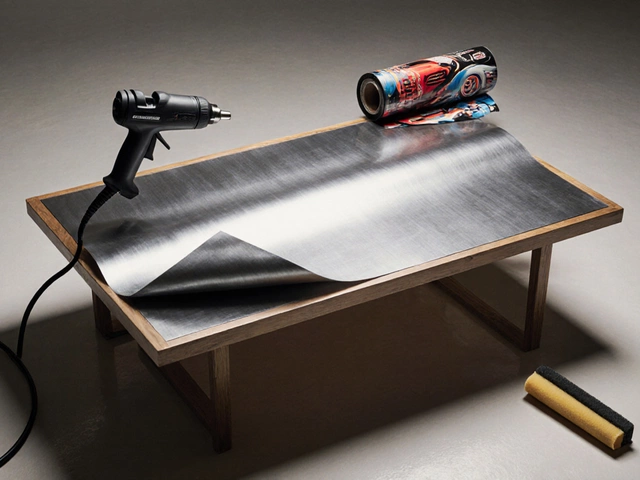Ever walked into an American house expecting a big old wardrobe and found just built-in doors in the wall instead? You’re not alone. In the U.S., nobody really says “wardrobe” when they’re talking about where they hang up their shirts and stash their shoes. Here, the universal term is “closet.” If it’s a walk-in or just a small nook with a rod and some shelves, it’s almost always called a closet—whether you’re shopping for a new home, watching HGTV, or helping your kid pick up their socks (which I do way more than I’d like to admit).
The confusion gets even bigger if you’re shopping at IKEA or any furniture store. At stores, you’ll spot both “wardrobe” and “closet organizers,” but most Americans just lump everything—free-standing or built-in—under “closet” unless it’s a piece of furniture you bought to stand against the wall. In that case, sure, you might see “wardrobe” on the tag, but people still ask, “Does this fit in the closet?” It’s not just about language; it’s about the way American houses are built, with closets already tucked away behind doors in almost every bedroom.
- Wardrobes vs. Closets: The American Difference
- Why 'Closet' Became the Go-To Word
- Where Do You Still Hear 'Wardrobe'?
- Shopping for Storage: Navigating American Stores
- Regional Slang and Surprising Exceptions
- Tips for Setting Up Your Own Closet Space
Wardrobes vs. Closets: The American Difference
If you grew up calling a big standing cabinet a wardrobe, living in the U.S. can feel confusing. Around here, people almost always say closet when talking about a place to keep clothes. The main difference? Closets are built into the walls and come with doors—no dragging heavy furniture across your bedroom floor. Wardrobes are usually separate pieces of furniture, like those old-school armoire-style cabinets you might see in movies or in your grandma's house.
Here’s where it gets more interesting: In most newer American homes, every bedroom comes with its own closet. It's so normal that U.S. real estate listings always list “number of closets,” and buyers expect built-in storage as a must. Rarely do Americans buy free-standing wardrobes unless their house is missing closets altogether. In cities with older houses—think places like Boston or San Francisco—wardrobes are a little more common because some old homes simply weren’t designed with closets.
Check out the breakdown:
| Closet | Wardrobe | |
|---|---|---|
| Definition | Built-in storage space, usually inside bedroom walls | Free-standing furniture for storing clothes |
| Most Common In | Modern American homes | Older homes or apartments lacking closets |
| Shopping Term | Closet system, closet organizer | Wardrobe, armoire |
| Space Needed | None (integrated into room) | Floor space required |
The numbers back it up. The U.S. Census found almost 90% of new single-family homes built after 2000 include closets in every bedroom. No wonder my son Aldo gets confused when cartoons talk about “wardrobes”—he’s never even seen one outside a furniture store.
If you’re setting up a bedroom in America, keep in mind: looking for “closet organizers” or “storage systems” will get you what you need, while “wardrobe” will usually only fetch you big, stand-alone cabinets.
Why 'Closet' Became the Go-To Word
So, how did Americans end up choosing “closet” over “wardrobe”? The answer’s all about how U.S. homes were built and how language shaped around it. Back in the late 1800s, when houses in the States started having more space, builders added small storage rooms or alcoves—usually right in the bedroom. Instead of buying big, heavy furniture, people just hung their clothes behind a door. It was practical, cheaper, and saved floor space. The word “closet” stuck because it fit this new style of home design.
If you look at homes built after 1940, nine out of ten have built-in closets. Compare that to older houses in the UK, where free-standing wardrobes ruled because homes were smaller and closets weren't on the blueprint. Americans just didn’t need the giant wooden wardrobes you see in British TV shows.
The word “closet” itself came from England, originally meaning a small private room, but Americans flipped it to mean a storage space. And by the 1950s, it was everywhere—in ads, catalogs, even movies. Take a glance at the numbers below:
| Year | % of New U.S. Homes With Built-in Closets |
|---|---|
| 1900 | 35% |
| 1940 | 80% |
| 1980 | 99% |
If you're traveling or shopping for furniture, you’ll hear “wardrobe” mostly at stores selling European-style furniture or when people want something free-standing. But in daily American life? It’s all about the closet.
Where Do You Still Hear 'Wardrobe'?
Even if most Americans say "closet," the word "wardrobe" hasn't disappeared. The word pops up in a few places, and knowing where can save you a lot of confusion—especially if you’re new in the States or just trying to buy the right thing.
First, when people talk about old movies or period dramas, "wardrobe" often means the big, free-standing cabinet for clothes. If you’ve ever seen The Lion, the Witch and the Wardrobe, you get the idea. These “wardrobes” are furniture, not built-ins.
Second, in theater and film, "wardrobe" refers to costumes or the department that handles outfits. If Aldo joins a school play, the teacher might say, "Check with the wardrobe department for your costume," not the closet department. It’s the same on Hollywood sets.
- Luxury furniture stores and catalogs: They’ll often call fancy, free-standing pieces a “wardrobe,” especially if it’s meant to add closet space in older houses without built-ins.
- Hotels and rental homes: When the room doesn’t have a built-in closet, you’ll sometimes see amenities described as including a “wardrobe.” It’s marketing, but it’s still used.
- Fashion: "Wardrobe" pops up when talking about someone’s whole collection of clothes. “I’m updating my summer wardrobe,” for example. Here, it doesn't mean the furniture at all—just the pile of shirts and shorts.
Take a look at where the "wardrobe" term comes up most in everyday U.S. life:
| Setting | Term Used | Why |
|---|---|---|
| Everyday homes | Closet | Built-in storage is the norm |
| Theater/Movies | Wardrobe | Refers to costumes, not furniture |
| Furniture stores | Wardrobe/Armoires | For free-standing clothes cabinets |
| Hotels/Rentals | Wardrobe | When built-in closets are missing |
| Fashion | Wardrobe | Means your clothing collection |
If you walk into an American furniture store and ask for a "wardrobe," they’ll point you to a big standalone cabinet, not the closet. But ask anyone where your jacket is and you’ll still hear, "Check the closet." So, while "wardrobe" is still around, it's more niche and context-based in the U.S. than you'd expect.
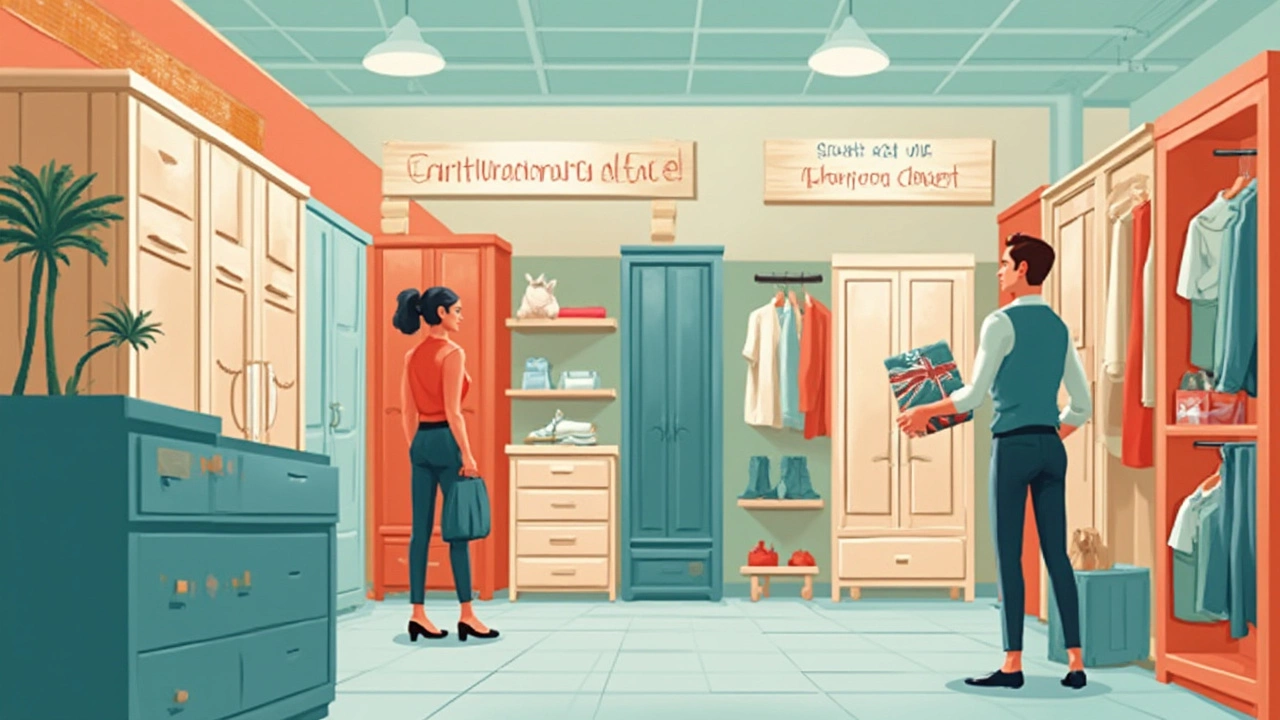
Shopping for Storage: Navigating American Stores
If you wander into a big American store looking for a wardrobe, you’ll probably end up in the closet section instead. In most U.S. stores—think Target, The Container Store, or Lowe’s—the main focus is on built-in closet storage, closet organizers, and modular shelving systems. Rarely will you see a huge selection of freestanding wardrobes. When you do spot one, it’s usually called an “armoire” or, plainly, a wardrobe, and it stands out as the exception.
The term wardrobe pops up mostly for those large, furniture-style pieces with doors, sometimes found at IKEA or Home Depot. If you want lots of options, IKEA might be your best bet—they even have their own line called “PAX” for customizable wardrobes. But at most stores, the staff understands “closet” miles better than “wardrobe.”
Here’s what to expect at common U.S. stores:
- Target, Walmart, Lowe’s, Home Depot: Find lots of closet rods, organizers, and shelves—almost everything for outfitting a built-in closet, barely any standalone wardrobes.
- IKEA: You’ll see both wardrobes and closet storage systems. The PAX system lets you build a freestanding wardrobe or a closet insert.
- The Container Store: Known for Elfa and custom closets. Freestanding wardrobes are rare.
It’s all about the built-ins in American homes. Stats from the U.S. Census show about 90% of homes built since 1990 have bedroom closets, so most folks are just looking for a way to organize what they already have instead of buying a new wardrobe cabinet.
| Store | Types of Storage Found | Good for Wardrobes? |
|---|---|---|
| Target | Closet organizers, shelving, bins | No, mostly closet-focused |
| IKEA | Wardrobes, closet systems | Yes, lots of freestanding wardrobes |
| Home Depot / Lowe's | Closet hardware, shelving, rods | Very limited |
| The Container Store | Closet organizers, custom systems | Hardly any wardrobes |
If you want a freestanding wardrobe for a room with no built-in closet, be clear and ask for an “armoire” or look in the bedroom furniture section. Online searches are easier—just enter “wardrobe cabinet” or “freestanding wardrobe” and skip the endless closet organizers. This saves time and keeps you from accidentally buying baskets when you wanted a place to hang your shirts. Trust me, that can happen.
Regional Slang and Surprising Exceptions
Even though most Americans just use “closet,” there are some pockets in the country where you’ll hear different terms. For example, in older parts of New England, some people still say “wardrobe,” but usually when they’re talking about a freestanding piece of furniture—think something antique, heavy, and passed down the family line. But walk into a newer house in Texas or California, and it’s always “closet,” no questions asked.
Growing up in the Midwest, I’d hear old-timers call that odd hallway closet a “chifforobe.” That word mixes “chest of drawers” and “wardrobe,” and you’ll mostly hear it from grandparents or in southern states. Another fun one: down South, especially in Louisiana and Mississippi, some families use “press” (short for linen press) for certain storage spots. But don’t expect your average American teenager to know what that means—unless they grew up around a lot of antiques.
Here’s a handy table showing where you might hear these terms and who’s saying them:
| Term | Region/Context | Who Uses It |
|---|---|---|
| Closet | All across the U.S. | Everyone, all generations |
| Wardrobe | Older homes, antique stores | Older adults, collectors |
| Chifforobe | Midwest, South | Grandparents, rural areas |
| Press | Deep South | Families with old houses |
If you’re moving into an older house, especially pre-1940s or in a historic part of town, don’t be surprised if there’s no closet built in—or if you spot a big wooden “wardrobe” standing against the wall instead. Modern building codes now usually require a closet in every bedroom, but houses before the 1950s often didn’t have them at all, so wardrobes were just everyday furniture.
Bottom line—when in doubt, say “closet.” But if your grandma starts talking about the “press,” just smile and ask her to show you what she means. You might even find a cool family story hiding in there along with some vintage sweaters.
Tips for Setting Up Your Own Closet Space
If you’ve ever stood in front of your closet thinking, “Where do I even start?”—you’re definitely not the only one. Americans deal with the same struggle all the time, and honestly, even a small space can look way bigger (or at least, way less chaotic) with a few tweaks. Here are some doable ways to get your closet working for you instead of against you.
- Start With a Clean Slate: Empty everything. Seriously, pile it all on the bed. Only put things back that you actually wear or use. Studies from The Container Store note that people typically wear just 20% of their clothes 80% of the time.
- Measure Your Space: Before you buy any shelves or kits, measure every inch: height, width, depth. American closets can range from just 24 inches deep for reach-ins, up to 6-8 feet for standard walk-ins.
- Maximize Vertical Real Estate: Stackable bins, double rods, and over-the-door organizers help a ton, especially in tight spaces.
- Use Matching Hangers: This simple trick saves space and makes everything look less messy—seriously, it makes a surprising difference.
- Put Everyday Items Front and Center: If you wear jeans five days a week, don’t cram them in the back. Easy access saves time and sanity.
- Invest in Lighting: A cheap motion-sensor LED strip helps prevent the dreaded morning outfit hunt in the dark.
"You don't need a walk-in to have an organized closet—you just need a plan," says Joanna Teplin from The Home Edit. "Keep like with like, stash seasonal stuff up top, and don't be afraid to let go of what you never wear."
Some folks love to label bins and baskets, while others stick to color-coding their shirts for quick visual picks. Whatever fits your personality, consistency always wins in the end.
| Average Closet Type | Approx. Size (feet) | Best Use |
|---|---|---|
| Reach-in | 2 x 6 | Kids’ rooms or smaller bedrooms |
| Walk-in | 6 x 6 or bigger | Master bedrooms, loads of storage |
| Wardrobe/Armoire | usually 2 x 3 | Older homes, freestanding storage |
The trick is making sure whatever system you choose matches your daily habits (and doesn’t cost a fortune to keep up). Sometimes, the best upgrades are as simple as a $10 shoe rack, a couple baskets, and thirty minutes of sorting while your dog tries to steal a sock. True story.

